CITROEN JUMPY 2009 Owner's Guide
Manufacturer: CITROEN, Model Year: 2009, Model line: JUMPY, Model: CITROEN JUMPY 2009Pages: 252, PDF Size: 12.15 MB
Page 31 of 252
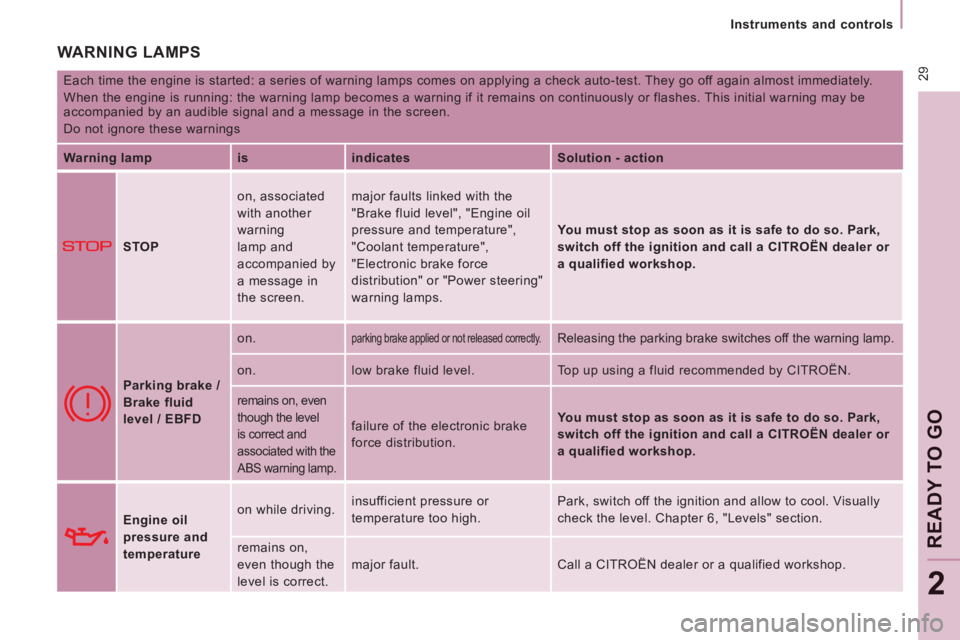
29
Instruments and controls
READY TO GO
2
WARNING LAMPS
Each time the engine is started: a series of warning lamps comes on appl\
ying a check auto-test. They go off again almost immediately.
When the engine is running: the warning lamp becomes a warning if it rem\
ains on continuously or flashes. This initial warning may be
accompanied by an audible signal and a message in the screen.
Do not ignore these warnings
Warning lamp is indicates Solution - action
STOP on, associated
with another
warning
lamp and
accompanied by
a message in
the screen. major faults linked with the
"Brake fluid level", "Engine oil
pressure and temperature",
"Coolant temperature",
"Electronic brake force
distribution" or "Power steering"
warning lamps.
You must stop as soon as it is safe to do so. Park,
switch off the ignition and call a CITROËN dealer or
a qualified workshop.
Parking brake /
Brake fluid
level / EBFD
on.
parking brake applied or not released correctly. Releasing the parking brake switches off the warning lamp.
on. low brake fluid level. Top up using a fluid recommended by CITROËN.
remains on, even
though the level
is correct and
associated with the
ABS warning lamp.
failure of the electronic brake
force distribution. You must stop as soon as it is safe to do so. Park,
switch off the ignition and call a CITROËN dealer or
a qualified workshop.
Engine oil
pressure and
temperature
on while driving.
insufficient pressure or
temperature too high. Park, switch off the ignition and allow to cool. Visually
check the level. Chapter 6, "Levels" section.
remains on,
even though the
level is correct. major fault.
Call a CITROËN dealer or a qualified workshop.
Page 32 of 252
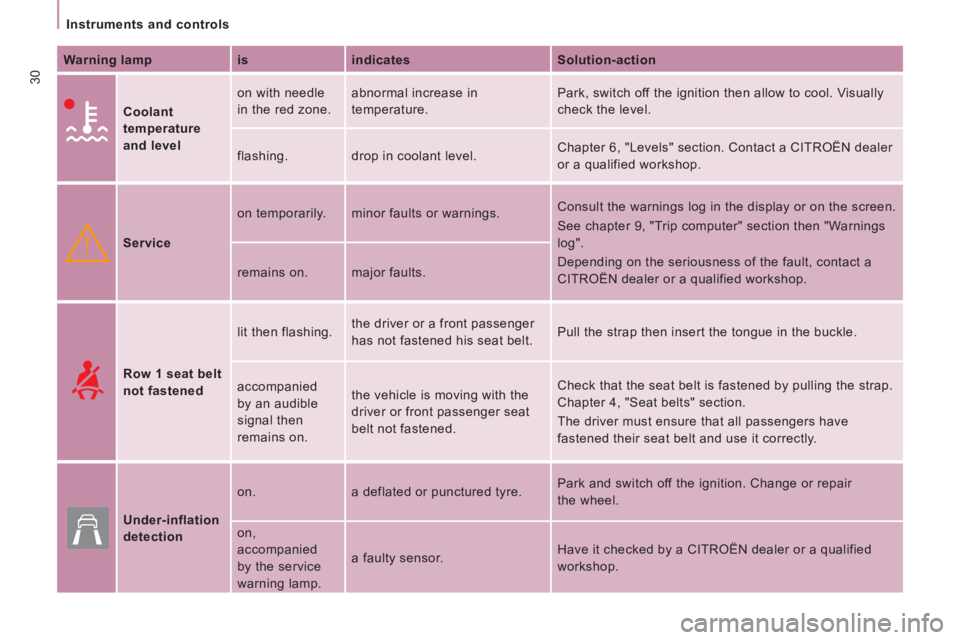
30
Instruments and controls
Warning lamp is indicates Solution-action
Coolant
temperature
and level
on with needle
in the red zone.
abnormal increase in
temperature. Park, switch off the ignition then allow to cool. Visually
check the level.
flashing. drop in coolant level. Chapter 6, "Levels" section. Contact a CITROËN dealer
or a qualified workshop.
Service on temporarily.
minor faults or warnings. Consult the warnings log in the display or on the screen.
See chapter 9, "Trip computer" section then "Warnings
log".
Depending on the seriousness of the fault, contact a
CITROËN dealer or a qualified workshop.
remains on.
major faults.
Row 1 seat belt
not fastened
lit then flashing.
the driver or a front passenger
has not fastened his seat belt. Pull the strap then insert the tongue in the buckle.
accompanied
by an audible
signal then
remains on. the vehicle is moving with the
driver or front passenger seat
belt not fastened. Check that the seat belt is fastened by pulling the strap.
Chapter 4, "Seat belts" section.
The driver must ensure that all passengers have
fastened their seat belt and use it correctly.
Under-inflation
detection
on.
a deflated or punctured tyre. Park and switch off the ignition. Change or repair
the wheel.
on,
accompanied
by the service
warning lamp. a faulty sensor.
Have it checked by a CITROËN dealer or a qualified
workshop.
Page 33 of 252
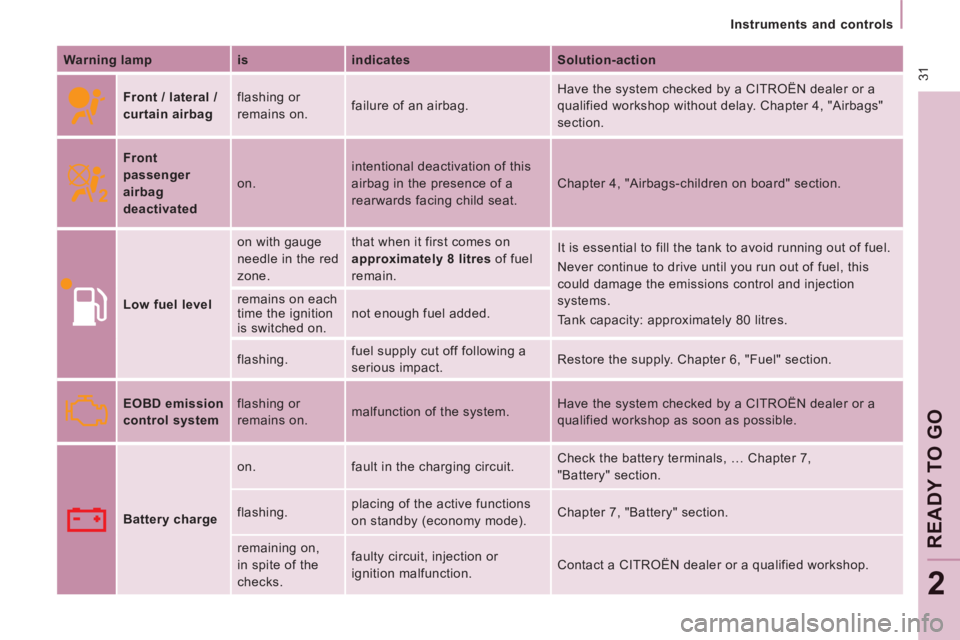
31
Instruments and controls
READY TO GO
2
Warning lamp is indicates Solution-action
Front / lateral /
curtain airbag
flashing or
remains on.
failure of an airbag. Have the system checked by a CITROËN dealer or a
qualified workshop without delay. Chapter 4, "Airbags"
section.
Front
passenger
airbag
deactivated
on.
intentional deactivation of this
airbag in the presence of a
rearwards facing child seat. Chapter 4, "Airbags-children on board" section.
Low fuel level on with gauge
needle in the red
zone.
that when it first comes on
approximately 8 litres of fuel
remain.
It is essential to fill the tank to avoid running out of fuel.
Never continue to drive until you run out of fuel, this
could damage the emissions control and injection
systems.
Tank capacity: approximately 80 litres.
remains on each
time the ignition
is switched on.
not enough fuel added.
flashing. fuel supply cut off following a
serious impact. Restore the supply. Chapter 6, "Fuel" section.
EOBD emission
control system
flashing or
remains on.
malfunction of the system. Have the system checked by a CITROËN dealer or a
qualified workshop as soon as possible.
Battery charge on.
fault in the charging circuit. Check the battery terminals, … Chapter 7,
"Battery" section.
flashing. placing of the active functions
on standby (economy mode). Chapter 7, "Battery" section.
remaining on,
in spite of the
checks. faulty circuit, injection or
ignition malfunction.
Contact a CITROËN dealer or a qualified workshop.
Page 34 of 252
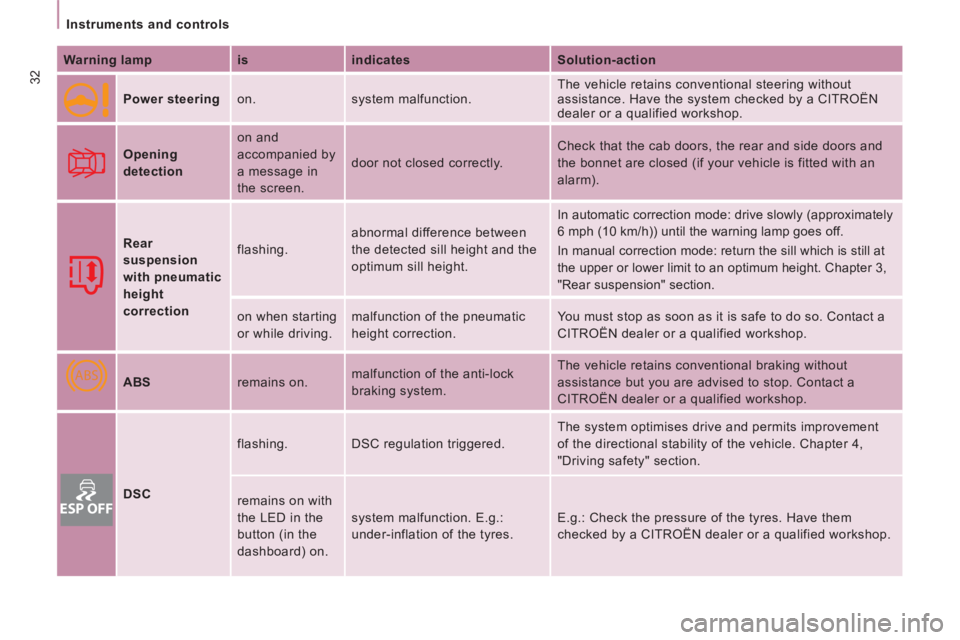
ABS
ESP OFF
32
Instruments and controls
Warning lamp is indicates Solution-action
Power steering on. system malfunction. The vehicle retains conventional steering without
assistance. Have the system checked by a CITROËN
dealer or a qualified workshop.
Opening
detection
on and
accompanied by
a message in
the screen.
door not closed correctly.
Check that the cab doors, the rear and side doors and
the bonnet are closed (if your vehicle is fitted with an
alarm).
Rear
suspension
with pneumatic
height
correction
flashing.
abnormal difference between
the detected sill height and the
optimum sill height. In automatic correction mode: drive slowly (approximately
6 mph (10 km/h)) until the warning lamp goes off.
In manual correction mode: return the sill which is still at
the upper or lower limit to an optimum height. Chapter 3,
"Rear suspension" section.
on when starting
or while driving. malfunction of the pneumatic
height correction. You must stop as soon as it is safe to do so. Contact a
CITROËN dealer or a qualified workshop.
ABS remains on. malfunction of the anti-lock
braking system. The vehicle retains conventional braking without
assistance but you are advised to stop. Contact a
CITROËN dealer or a qualified workshop.
DSC flashing.
DSC regulation triggered. The system optimises drive and permits improvement
of the directional stability of the vehicle. Chapter 4,
"Driving safety" section.
remains on with
the LED in the
button (in the
dashboard) on. system malfunction. E.g.:
under-inflation of the tyres.
E.g.: Check the pressure of the tyres. Have them
checked by a CITROËN dealer or a qualified workshop.
Page 35 of 252
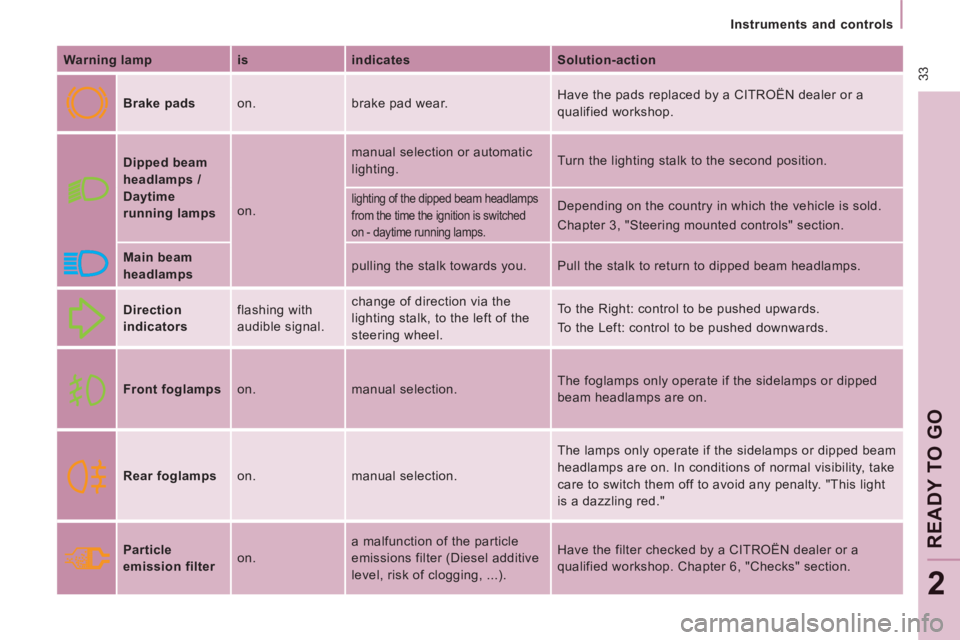
33
Instruments and controls
READY TO GO
2
Warning lamp is indicates Solution-action
Brake pads on. brake pad wear. Have the pads replaced by a CITROËN dealer or a
qualified workshop.
Dipped beam
headlamps /
Daytime
running lamps
on. manual selection or automatic
lighting.
Turn the lighting stalk to the second position.
lighting of the dipped beam headlamps
from the time the ignition is switched
on - daytime running lamps. Depending on the country in which the vehicle is sold.
Chapter 3, "Steering mounted controls" section.
Main beam
headlamps pulling the stalk towards you.
Pull the stalk to return to dipped beam headlamps.
Direction
indicators
flashing with
audible signal. change of direction via the
lighting stalk, to the left of the
steering wheel. To the Right: control to be pushed upwards.
To the Left: control to be pushed downwards.
Front foglamps on. manual selection. The foglamps only operate if the sidelamps or dipped
beam headlamps are on.
Rear foglamps on. manual selection. The lamps only operate if the sidelamps or dipped beam
headlamps are on. In conditions of normal visibility, take
care to switch them off to avoid any penalty. "This light
is a dazzling red."
Particle
emission filter
on. a malfunction of the particle
emissions filter (Diesel additive
level, risk of clogging, ...). Have the filter checked by a CITROËN dealer or a
qualified workshop. Chapter 6, "Checks" section.
Page 36 of 252

34
Instruments and controls
Screen is indicates Solution-action
Cruise control on. cruise control selected. Manual selection. Chapter 3, "Steering mounted
controls" section.
Speed limiter on. speed limiter selected. Manual selection. Chapter 3, "Steering mounted
controls" section.
Gear efficiency
indicat or
on. a recommendation that is
independent of the traffic
configuration and density. To reduce fuel consumption, engage the gear
recommended with a manual gearbox.
The driver retains responsibility for following this
indication or not.
Diesel
pre-heating
on. climatic conditions requiring
pre-heating. Wait until the warning lamp goes off before operating
the starter.
Particle
emissions filter
on. a malfunction of the particle
emissions filter (Diesel additive
level, risk of clogging, ...). Have the filter checked by a CITROËN dealer or a
qualified workshop.
Chapter 6, "Checks" section.
Presence of
water in the
Diesel filter
on and
accompanied by
a message in
the screen.
water in the Diesel filter.
Have the filter bled by a CITROËN dealer or a qualified
workshop without delay.
Chapter 6, "Checks" section.
Service
spanner
on.
service due shortly. Refer to the list of checks in maintenance and warranty
guide. Have the service carried out by a CITROËN
dealer or a qualified workshop.
Time on. adjustment of the time. Use the left-hand button on the instrument panel. Chapter 2,
at the beginning of the "Instruments and controls" section.
Page 37 of 252
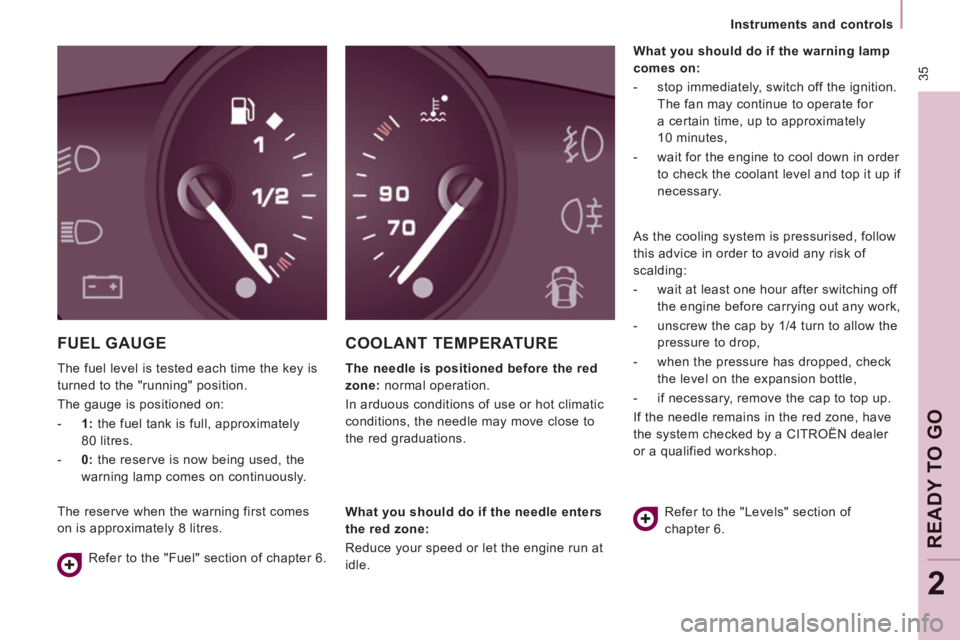
35
Instruments and controls
READY TO GO
2
FUEL GAUGE
The fuel level is tested each time the key is
turned to the "running" position.
The gauge is positioned on:
- 1: the fuel tank is full, approximately 80 litres.
- 0: the reserve is now being used, the warning lamp comes on continuously.
COOLANT TEMPERATURE
The needle is positioned before the red
zone: normal operation.
In arduous conditions of use or hot climatic
conditions, the needle may move close to
the red graduations. What you should do if the warning lamp
comes on:
- stop immediately, switch off the ignition. The fan may continue to operate for
a certain time, up to approximately
10 minutes,
- wait for the engine to cool down in order to check the coolant level and top it up if
necessary.
Refer to the "Fuel" section of chapter 6. What you should do if the needle enters
the red zone:
Reduce your speed or let the engine run at
idle. Refer to the "Levels" section of
chapter 6.
The reserve when the warning first comes
on is approximately 8 litres. As the cooling system is pressurised, follow
this advice in order to avoid any risk of
scalding:
- wait at least one hour after switching off
the engine before carrying out any work,
- unscrew the cap by 1/4 turn to allow the pressure to drop,
- when the pressure has dropped, check the level on the expansion bottle,
- if necessary, remove the cap to top up.
If the needle remains in the red zone, have
the system checked by a CITROËN dealer
or a qualified workshop.
Page 38 of 252
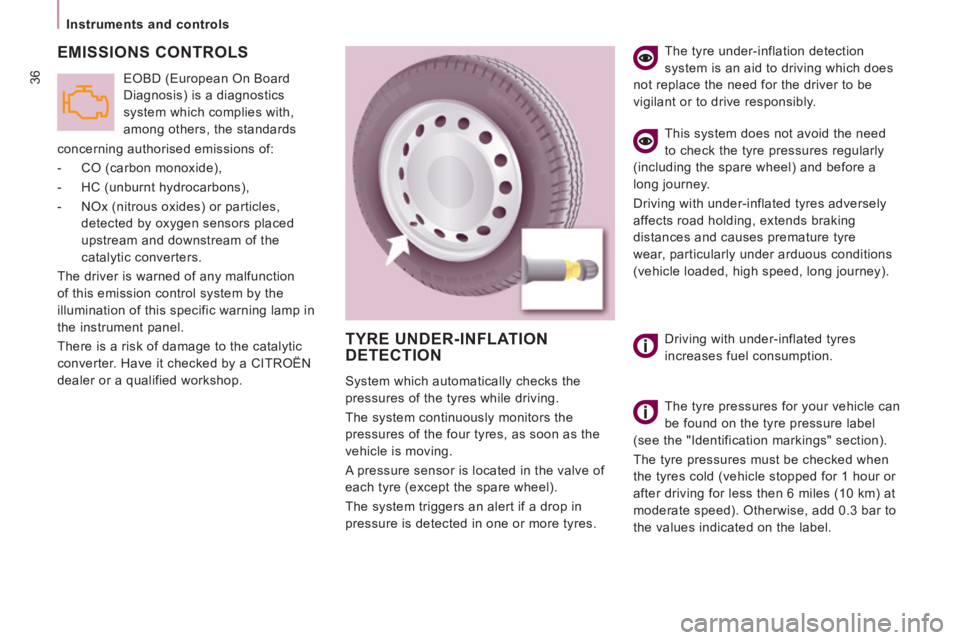
36
Instruments and controls
EMISSIONS CONTROLS
concerning authorised emissions of:
- CO (carbon monoxide),
- HC (unburnt hydrocarbons),
- NOx (nitrous oxides) or particles, detected by oxygen sensors placed
upstream and downstream of the
catalytic converters.
The driver is warned of any malfunction
of this emission control system by the
illumination of this specific warning lamp in
the instrument panel.
There is a risk of damage to the catalytic
converter. Have it checked by a CITROËN
dealer or a qualified workshop. EOBD (European On Board
Diagnosis) is a diagnostics
system which complies with,
among others, the standards
TYRE UNDER-INFLATION DETECTION
System which automatically checks the
pressures of the tyres while driving.
The system continuously monitors the
pressures of the four tyres, as soon as the
vehicle is moving.
A pressure sensor is located in the valve of
each tyre (except the spare wheel).
The system triggers an alert if a drop in
pressure is detected in one or more tyres. The tyre under-inflation detection
system is an aid to driving which does
not replace the need for the driver to be
vigilant or to drive responsibly.
This system does not avoid the need
to check the tyre pressures regularly
(including the spare wheel) and before a
long journey.
Driving with under-inflated tyres adversely
affects road holding, extends braking
distances and causes premature tyre
wear, particularly under arduous conditions
(vehicle loaded, high speed, long journey).
Driving with under-inflated tyres
increases fuel consumption.
The tyre pressures for your vehicle can
be found on the tyre pressure label
(see the "Identification markings" section).
The tyre pressures must be checked when
the tyres cold (vehicle stopped for 1 hour or
after driving for less then 6 miles (10 km) at
moderate speed). Otherwise, add 0.3 bar to
the values indicated on the label.
Page 39 of 252
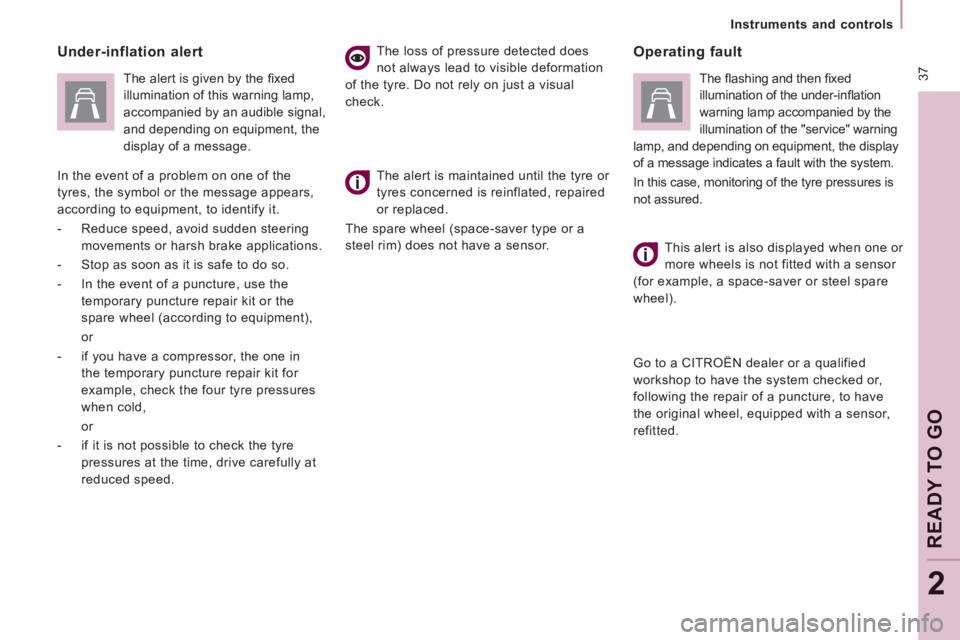
37
Instruments and controls
READY TO GO
2
Under-inflation alert
The alert is given by the fi xed
illumination of this warning lamp,
accompanied by an audible signal,
and depending on equipment, the
display of a message.
In the event of a problem on one of the
tyres, the symbol or the message appears,
according to equipment, to identify it.
- Reduce speed, avoid sudden steering movements or harsh brake applications.
- Stop as soon as it is safe to do so.
- In the event of a puncture, use the temporary puncture repair kit or the
spare wheel (according to equipment),
or
- if you have a compressor, the one in the temporary puncture repair kit for
example, check the four tyre pressures
when cold,
or
- if it is not possible to check the tyre pressures at the time, drive carefully at
reduced speed. The loss of pressure detected does
not always lead to visible deformation
of the tyre. Do not rely on just a visual
check.
The alert is maintained until the tyre or
tyres concerned is reinflated, repaired
or replaced.
The spare wheel (space-saver type or a
steel rim) does not have a sensor.
Operating fault
The fl ashing and then fi xed
illumination of the under-infl ation
warning lamp accompanied by the
illumination of the "service" warning
lamp, and depending on equipment, the display
of a message indicates a fault with the system.
In this case, monitoring of the tyre pressures is
not assured.
This alert is also displayed when one or
more wheels is not fitted with a sensor
(for example, a space-saver or steel spare
wheel).
Go to a CITROËN dealer or a qualified
workshop to have the system checked or,
following the repair of a puncture, to have
the original wheel, equipped with a sensor,
refitted.
Page 40 of 252
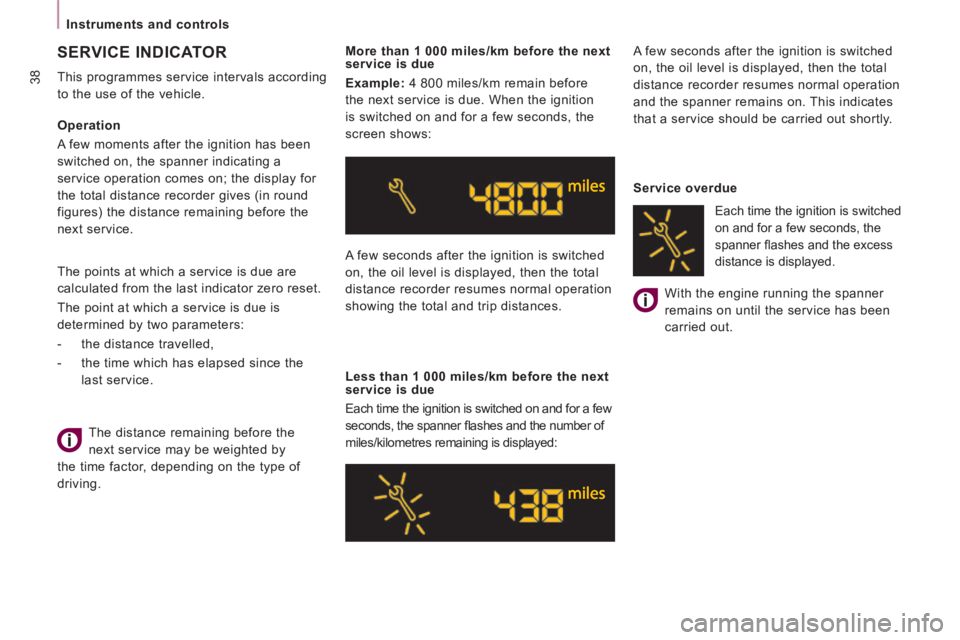
38
Instruments and controls Service overdue With the engine running the spanner
remains on until the service has been
carried out.
Each time the ignition is switched
on and for a few seconds, the
spanner fl ashes and the excess
distance is displayed.
Operation
A few moments after the ignition has been
switched on, the spanner indicating a
service operation comes on; the display for
the total distance recorder gives (in round
figures) the distance remaining before the
next service. A few seconds after the ignition is switched
on, the oil level is displayed, then the total
distance recorder resumes normal operation
showing the total and trip distances.
Less than 1 000 miles/km before the next
service is due
Each time the ignition is switched on and for a few
seconds, the spanner fl ashes and the number of
miles/kilometres remaining is displayed: A few seconds after the ignition is switched
on, the oil level is displayed, then the total
distance recorder resumes normal operation
and the spanner remains on. This indicates
that a service should be carried out shortly.
The distance remaining before the
next service may be weighted by
the time factor, depending on the type of
driving. More than 1 000 miles/km before the next
service is due
Example: 4 800 miles/km remain before
the next service is due. When the ignition
is switched on and for a few seconds, the
screen shows:
SERVICE INDICATOR
This programmes service intervals according
to the use of the vehicle.
The points at which a service is due are
calculated from the last indicator zero reset.
The point at which a service is due is
determined by two parameters:
- the distance travelled,
- the time which has elapsed since the
last service.